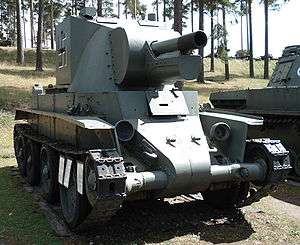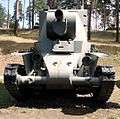BT-42
The BT-42 was a Finnish assault gun, constructed during the Continuation War. It was constructed from captured Soviet BT-7 light tanks and British 4.5-inch howitzers (114 mm-calibre light howitzer, model 1908) from 1918, which had been donated during the Winter War. Only eighteen vehicles were constructed.
| BT-42 | |
|---|---|
 BT-42 in Parola Tank Museum | |
| Type | Assault gun |
| Place of origin | Finland |
| Service history | |
| In service | 1943-1944 |
| Used by | Finland |
| Wars | Continuation War |
| Production history | |
| Produced | 1942 |
| No. built | 18 |
| Variants | BT-43 |
| Specifications | |
| Mass | 15 tonnes |
| Length | 5.7 m (18 ft 8 in) |
| Width | 2.1 m (6 ft 11 in) |
| Height | 2.2 m (7 ft 3 in) |
| Crew | 3 |
| Armor | 6-16 mm |
Main armament | 114 mm (4.5-inch) howitzer (50 rounds) |
| Engine | Mikulin M-17T V-12 gasoline engine 500 hp (370 kW) |
| Power/weight | 33.33 hp/tonne |
| Suspension | Christie |
| Ground clearance | 0.31 m |
Operational range | 375 km (233 mi) |
| Maximum speed | 53 km/h (33 mph) |
Development and use
As the Second World War progressed, the Soviets were fielding better and better tanks. The Finnish Army, on the other hand, had to make do with a large number of captured tanks, which were for the most part lightly armored and armed.
The Finns decided to redesign the BT-7 Model 1937 tank. They constructed a new turret and armed it with British-made 114.3 mm howitzers that had been supplied by the British during the Winter War (Q.F. 4,5 inch howitzer Mark II, also known as 114 Psv.H/18 in Finland). Eighteen BT-42 were built and these were pressed into service in 1943.
These converted vehicles quickly became very unpopular with their crews. The weaknesses could mainly be attributed to the new turret, which apart from giving the tank a high-profile also added significant weight to the vehicle, stressing the suspension and the engine.
The BT-42 was used for the first time in 1943, at the Svir River, where it was used against enemy pillboxes. The design worked reasonably well against soft targets but was completely unsuitable for anti-tank warfare. To counter this, the Finns copied a German-designed HEAT round for the gun and it was initially thought that it would be effective against the sloped armour of the T-34. However, problems arose with the copied HEAT shells fuses, which apparently did not arm themselves correctly after firing, due to the different muzzle velocity and round spin rate of the 4.5 inch howitzer compared to the original German guns.[1]
The BT-42s were used again during the major Soviet offensive in 1944. They were deployed in the defence of Vyborg. In one encounter, a Finnish BT-42 hit a Soviet T-34 18 times, failing even to immobilize the enemy vehicle, as this vehicle's fuses failed to work correctly. Eight of the 18 BT-42s in action made no significant contribution to the fighting. At the time Finnish armored units were still composed mostly of older designs such as the Vickers 6-Ton, T-26 and T-28 tanks, and all of these suffered losses.
Emergency supplies of Panzer IV tanks and StuG III self-propelled assault guns from Germany, as well as captured T-34s, made it possible for the Finns to replace its losses with more effective vehicles. The BT-42 was retired soon after the Vyborg battles, replaced in their intended role by German-made StuG IIIs.
 Front view
Front view Left-rear quarter view
Left-rear quarter view
See also
- BT-43 - another Finnish conversion of BT-7 tank
Footnotes
- The Finnish HEAT shell was called "114 hkr 42/C-18/24-38 is 32-18/24" and it was equipped with a "Hl/C" warhead. The German 10.5 cm HEAT grenade, which it had been modelled after, could penetrate 100 mm of steel at a 60-degree angle of impact. Thus it was estimated that the Finnish shell, with its larger calibre, could penetrate 110-115 mm, but its fuse very often failed to function properly, leaving the projectile simply bouncing off on impact without doing any meaningful damage.
External links
- Specifications and operational use at www.jaegerplatoon.net